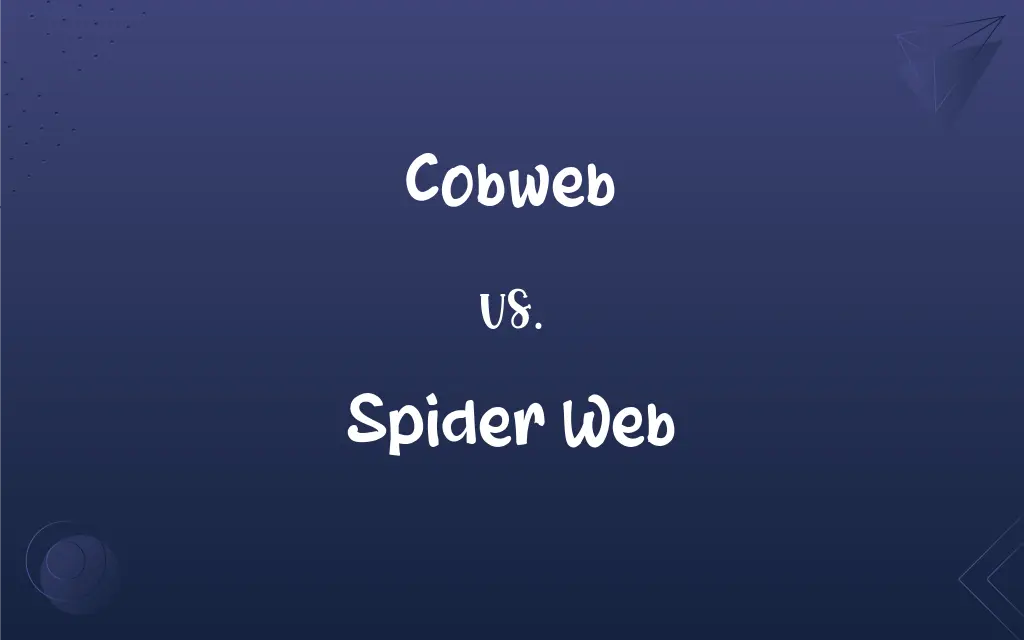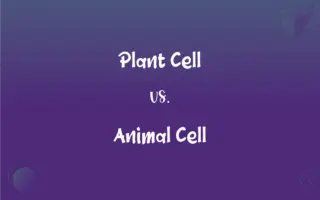Cobweb vs. Spider Web: What's the Difference?
Edited by Aimie Carlson || By Harlon Moss || Updated on October 7, 2023
Cobweb is a web spun by a spider to catch its prey, often found indoors and may be old or dusty. Spider Web is a silken structure created by a spider, meant to catch its prey and may be found in various environments.

Key Differences
Cobweb and spider web, while seemingly synonymous, have subtle distinctions worth noting. A cobweb usually pertains to old, dusty spider webs found primarily indoors or in sheltered locations. Cobwebs can often be associated with neglect or areas that have not been cleaned for a while. In contrast, the term "spider web" tends to embody a broader connotation, referring to all intricate, silken structures created by spiders, whether found indoors or outdoors, and irrespective of their age.
Diving into the anatomy of the cobweb, it often exhibits a tangled, somewhat messy appearance. Cobwebs tend to be irregular, with no definitive pattern or shape, and are spun by various species of house spiders. On the flip side, spider webs can present a variety of designs and shapes, such as the iconic spiral orb webs, crafted meticulously by different species of spiders. This variability in spider web architecture demonstrates the adaptability and diversity of spiders as a species.
Furthermore, cobwebs are notably less sticky compared to some spider webs. Cobwebs, often being older and having collected dust, lose the stickiness that is inherent in freshly spun spider webs. Spider webs, especially those spun by orb-weaver spiders, are renowned for their stickiness, which effectively captures prey. The purposeful engineering behind spider web construction illustrates the strategic approach spiders take towards hunting.
It’s also notable that cobwebs are commonly linked with spooky or eerie settings due to their association with abandoned, undisturbed areas. They have woven themselves into cultural and media portrayals as symbols of desolation or haunting. Spider webs, on the contrary, might be observed in a plethora of settings, including vibrant natural environments, highlighting the spider’s widespread habitat and versatile web-spinning capabilities.
Lastly, from a symbolic perspective, cobwebs often symbolize neglect, lapse, or time passing without activity in metaphors and idioms. Comparatively, spider webs might symbolize complexity, entrapment, or diligence due to the spider’s careful and strategic web-weaving. Both terms, while rooted in arachnid activity, have woven their way into language and symbolism, each carrying its own set of connotations and imagery.
ADVERTISEMENT
Comparison Chart
Location
Primarily indoors
Can be found anywhere
Age & Condition
Often old and dusty
Can be fresh and sticky
Symbolism
Neglect, old age, desolation
Complexity, diligence, entrapment
Typical Appearance
Tangled, irregular
Can be various shapes and sizes
Cultural Associations
Associated with haunted settings
Used in various contexts
ADVERTISEMENT
Cobweb and Spider Web Definitions
Cobweb
A cobweb is often an old and abandoned spider web that collects dust over time.
The attic was filled with cobwebs, untouched for years.
Spider Web
Spider web refers to the complex, often geometric structures spun by spiders.
Scientists study the spider web for its strength and architectural brilliance.
Cobweb
Cobweb can symbolize neglect or areas that have been undisturbed for a lengthy period.
After the shop closed down, it soon became shrouded in cobwebs.
Spider Web
Spider web can symbolize entrapment, complexity, or the passage of time.
In literature, a spider web often alludes to complex, entangled relationships.
Cobweb
Cobweb may metaphorically describe a state of mental confusion or fuzziness.
After the long nap, she tried to shake the cobwebs from her mind.
Spider Web
Spider web holds various meanings in different cultural and spiritual contexts.
Some Native American cultures revere the spider web as a symbol of life’s intricate connections.
Cobweb
Cobweb is often utilized in literature and art to depict eeriness, abandonment, or time passage.
The eerie illustration of the haunted house was incomplete without the cobwebs draping from the ceiling.
Spider Web
A spider web is a structure created by a spider used to catch its prey.
The morning dew highlighted the intricacy of the spider web in the garden.
Cobweb
Cobweb usually pertains to the webs found indoors or in sheltered, undisturbed locations.
The basement corners were adorned with cobwebs, signaling long-time neglect.
Spider Web
Spider web encompasses diverse web shapes and sizes constructed by different spider species.
Walking through the forest, she marveled at the variety of spider web designs.
Cobweb
A spiderweb, especially an old one that is covered in dust.
Cobweb
A single thread spun by a spider.
Cobweb
Something resembling a spiderweb in gauziness or flimsiness
"An extraordinary number of elegant ladies ... flowed in, heels clicking, diamonds flashing, adjusting tiny cobwebs of priceless lace on immaculate coiffures" (Jane Stevenson).
FAQs
Can spider webs be found indoors like cobwebs?
Absolutely, spider webs can be found anywhere, indoors or outdoors, and are not necessarily old or dusty like cobwebs.
Do all spiders create webs?
No, not all spider species create webs; some hunt or ambush their prey without the use of a web.
How is a spider web different from a cobweb?
While cobwebs are usually old and dusty, spider webs can be fresh and are found in various environments, exhibiting different shapes and designs.
Can a spider web turn into a cobweb?
Yes, when a spider web is abandoned and collects dust over time, it becomes what is commonly referred to as a cobweb.
How do spiders create their webs?
Spiders produce silk from spinnerets, strategically placing and stretching it to create various web designs.
How strong is a spider web?
Spider web silk is incredibly strong for its diameter, even compared to steel, and exhibits remarkable tensile strength.
Are cobwebs always created by spiders?
Primarily yes, cobwebs are originated from spiders but might be left abandoned and accrue dust and debris over time.
Can cobwebs be found outdoors?
While primarily associated with indoor or sheltered spaces, cobwebs can occasionally be found outdoors in undisturbed areas.
How can I prevent cobwebs in my house?
Regular cleaning, reducing clutter, and using spider repellents can help prevent cobwebs in the home.
Can I use spider web designs in art or decor without symbolizing neglect?
Absolutely, spider web designs can symbolize various concepts and can be utilized in art and decor in a manner that suits your desired symbolism.
Are all spider webs sticky?
Many spider webs are sticky to effectively capture prey, but not all spider webs exhibit this characteristic.
Are cobwebs found globally?
Yes, cobwebs can be found worldwide, anywhere spiders inhabit and humans dwell.
Why do cobwebs often found in unused spaces?
Cobwebs are usually associated with unused spaces due to the lack of disturbance, allowing them to remain and collect dust.
Why are spider webs often symmetrical and geometric?
Spider webs often exhibit symmetry and geometric patterns due to the spider’s innate building technique, aiming for effective prey capture and stability.
What is a cobweb?
A cobweb is often an old, abandoned spider web, typically found indoors and associated with neglect due to its dusty appearance.
What symbolizes a cobweb in literature or art?
Cobwebs often symbolize neglect, abandonment, and the passage of time in literature and art.
What is the function of a spider web?
The primary function of a spider web is to trap prey, although different species use varied web structures and strategies for this purpose.
What does a spider web symbolize in different cultures?
In various cultures, spider webs can symbolize creativity, complexity, and destiny due to their intricate designs.
Are cobwebs harmful to humans?
Cobwebs themselves are not harmful but can indicate the presence of spiders and contribute to indoor allergens.
Can the design of a spider web identify spider species?
Yes, different spider species create distinctive web designs that can often assist in identification.
About Author
Written by
Harlon MossHarlon is a seasoned quality moderator and accomplished content writer for Difference Wiki. An alumnus of the prestigious University of California, he earned his degree in Computer Science. Leveraging his academic background, Harlon brings a meticulous and informed perspective to his work, ensuring content accuracy and excellence.
Edited by
Aimie CarlsonAimie Carlson, holding a master's degree in English literature, is a fervent English language enthusiast. She lends her writing talents to Difference Wiki, a prominent website that specializes in comparisons, offering readers insightful analyses that both captivate and inform.































































